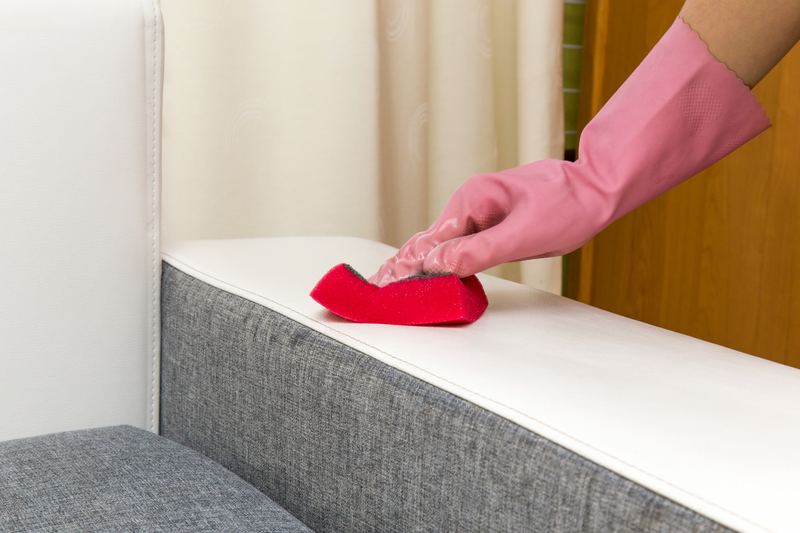Air Quality Focus: Enhancing Indoor Environments for Health
Posted on 18/06/2025
Air Quality Focus: Enhancing Indoor Environments for Health
Good air quality isn't just something to wish for outdoors. Inside our homes, offices, and classrooms, the air we breathe shapes our health, productivity, and comfort every day. In this comprehensive article, we focus on indoor air quality and explore effective strategies to create cleaner, healthier environments indoors.

Why Indoor Air Quality Deserves Our Attention
Most people spend up to 90% of their lives indoors, relying on the safety and comfort of buildings to shield them from outdoor pollution. However, research reveals that indoor air pollution levels are often 2 to 5 times higher than those outdoors. Poor air quality inside can trigger allergies, asthma attacks, headaches, fatigue, and even increase the risk of long-term chronic diseases.
- Short-term symptoms: Eye, nose, and throat irritation; coughing; headaches; dizziness; fatigue
- Long-term effects: Respiratory diseases, heart disease, cancer, worsening asthma, and reduced cognitive function
Investing in better indoor air quality is an investment in overall well-being.
Underlining Key Factors Influencing Indoor Air Quality
- Ventilation rates
- Presence of indoor pollutants (chemicals, dust, mold, VOCs)
- Humidity levels
- Temperature control
- Occupant activities (cooking, cleaning, smoking)
- Outdoor air quality
Each of these factors interacts, making it essential to adopt a holistic approach when aiming to enhance indoor environments for health.
Common Sources of Indoor Air Pollution
To boost air quality in indoor environments, we must first identify and understand the sources of contaminants:
- Biological pollutants: Mold, bacteria, viruses, pet dander, dust mites, and pollen
- Chemical pollutants: Volatile organic compounds (VOCs) from paints, cleaning products, furniture, and building materials
- Combustion by-products: Carbon monoxide, nitrogen dioxide, and particulates from gas stoves, fireplaces, and tobacco smoke
- Particulate matter: Dust, soot, pollen, smoke, and fibers
Identifying these sources is the first critical step in improving indoor air quality for health benefits.
Key Strategies to Enhance Indoor Air Quality
1. Ventilation: Bringing in Fresh Air
Proper ventilation is the cornerstone of any air quality improvement plan. Without enough airflow, pollutants become trapped, concentrations build, and indoor environments become stagnant.
- Open windows and doors when weather and outdoor air quality permit
- Use exhaust fans in kitchens and bathrooms to remove contaminants directly at the source
- Consider installing a whole-house ventilation system or energy recovery ventilator (ERV)
- Regularly check and maintain your HVAC system for peak performance
2. Filtration: Capturing Harmful Particles
Effective air filtration can significantly reduce allergens, particulate matter, and even chemicals indoors.
- Install high-efficiency air filters (MERV 13 or higher) in your home's HVAC system
- Use portable HEPA air purifiers in high-traffic or allergy-prone rooms
- Maintain and replace filters according to manufacturer guidelines
3. Source Control: Eliminating Contaminant Origins
The most effective way to enhance indoor air quality is to eliminate pollutants before they spread. Identify and address sources instead of relying solely on ventilation or filtration.
- Avoid smoking indoors; it releases hundreds of toxic chemicals
- Choose low-VOC paints, finishes, and furnishings
- Store chemicals and cleaning products in sealed containers, away from living areas
- Repair leaks to prevent mold growth and moisture problems
- Reduce use of candles and incense, which can add particulates and soot to the air
4. Humidity Control: Balancing Moisture
Humidity plays a crucial role in indoor environmental quality. High humidity encourages mold and dust mites, while low humidity can cause dryness and discomfort.
- Maintain indoor relative humidity between 30%-50%
- Use dehumidifiers in damp spaces or during humid seasons
- Employ humidifiers in dry, heated environments, but monitor to prevent excess moisture
5. Regular Cleaning: Minimizing Allergens and Pollutants
Routine cleaning, using safe products, is essential in maintaining a healthy indoor atmosphere.
- Vacuum carpets and upholstered furniture with HEPA filter vacuums
- Damp-mop hard floors to remove settled dust
- Launder bedding and curtains regularly to minimize dust mites and allergens
- Avoid clutter, which harbors dust and makes cleaning less effective
6. Plants: Nature's Air Purifiers?
Houseplants are often promoted as natural boosters for indoor air environments. While they are aesthetically pleasing and may absorb some VOCs, studies show their real impact is minimal compared to ventilation and filtration.
- Enjoy houseplants for their beauty, but don't rely on them alone for air purification
- Be cautious--overwatering can promote mold growth or attract pests
The Importance of Monitoring Indoor Air Quality
With invisible threats lurking in the air, measuring indoor air quality is the best way to identify problems and evaluate solutions.
- Use air quality monitors to track pollutants like particulate matter, CO2, VOCs, and humidity levels
- Modern smart sensors can alert you to unhealthy spikes and connect to apps for real-time tracking
- Regularly inspect and test for mold, especially after leaks or water damage
Tracking data over time helps uncover trends and shape your next steps for healthier indoor conditions.
Special Considerations for Different Indoor Environments
Homes
- Ensure gas appliances are vented and maintained
- Prohibit smoking indoors in multi-unit dwellings
- Pay special attention to children's rooms and nurseries, as young lungs are especially vulnerable
Offices
- Increase outdoor air exchange in HVAC systems
- Use zero or low-VOC office supplies and furnishings
- Address water leaks and spills immediately to prevent mold proliferation
Schools and Daycares
- Maintain high levels of ventilation, particularly in classrooms and play areas
- Use safe, non-toxic cleaning supplies
- Educate staff, students, and parents on healthy air habits
Emerging Technologies for Indoor Air Quality
The landscape for air cleaning technologies is rapidly evolving. Here are a few promising options:
- Ultraviolet germicidal irradiation (UVGI): Destroys bacteria, viruses, and mold spores in air ducts or standalone devices
- Ionization air purifiers: Cling to airborne particles for easier filter removal--but be wary of ozone production
- Photocatalytic oxidation (PCO): Uses light and catalysts to break down organic pollution
- Smart ventilation controls: Adjust airflow dynamically based on indoor pollutant levels for optimal air exchange
These advanced solutions can complement traditional approaches and provide even greater air quality improvement when professionally installed and maintained.

Benefits of Prioritizing Indoor Air Quality
- Healthier occupants: Fewer respiratory symptoms, allergy flare-ups, and infections
- Enhanced productivity: Sharper focus and cognitive function, especially in work and learning environments
- Better sleep: Clean air means less congestion and more restful nights
- Improved property value: A focus on air quality is a selling point for eco-conscious buyers and tenants
- Environmental gains: Efficient ventilation and filtration can also reduce energy consumption and your carbon footprint
Conclusion: Your Path to Cleaner Indoor Air
Today's society increasingly recognizes the critical role of indoor air quality in health and well-being. By taking a comprehensive, proactive approach--prioritizing ventilation, filtration, source control, humidity management, and regular monitoring--you can transform your indoor spaces into true sanctuaries for health.
Whether at home, in the workplace, or at school, commit to making air quality a central focus. Breathe easier, live better, and cultivate environments that support vibrant living!
Action Checklist: Enhancing Indoor Environments for Health
- Assess your current indoor air quality with sensors or professional inspections
- Adopt rigorous cleaning routines and use low-emission products
- Boost ventilation and filtration for cleaner, fresher air
- Control sources of moisture and fix leaks promptly
- Educate household or facility members about air-friendly habits
- Stay updated on new technologies and best practices for indoor environmental quality
Don't leave your indoor air quality to chance. Make every breath count by focusing on enhancing your indoor environment for lifelong health.





